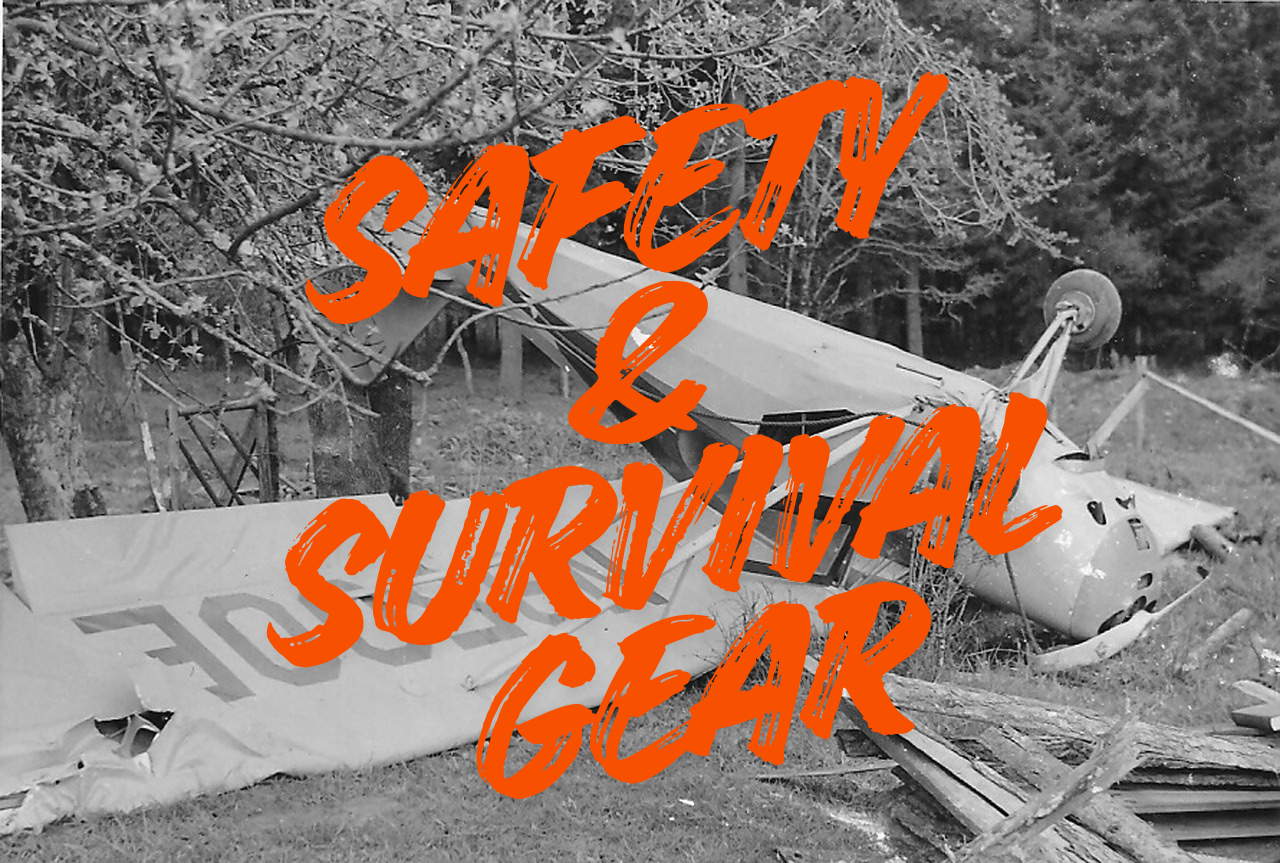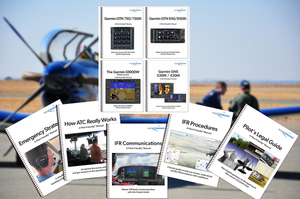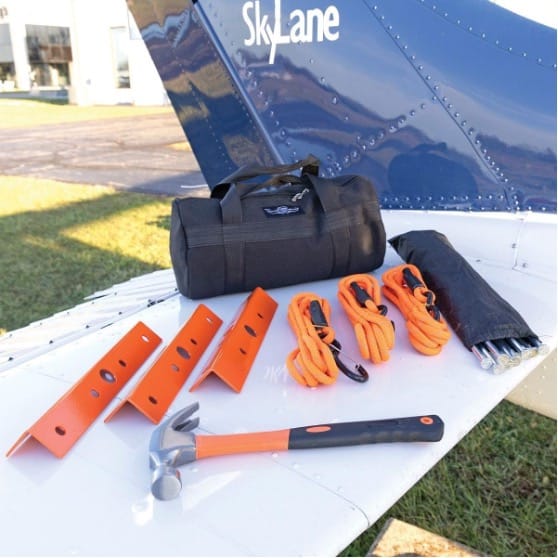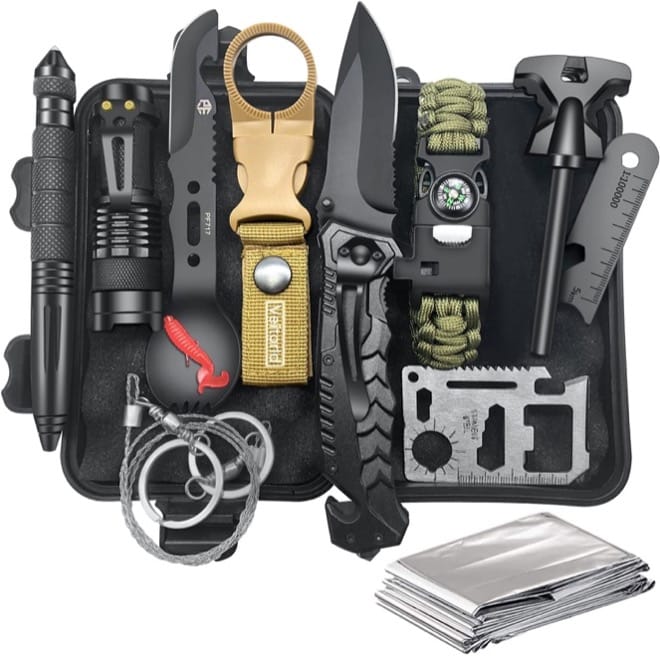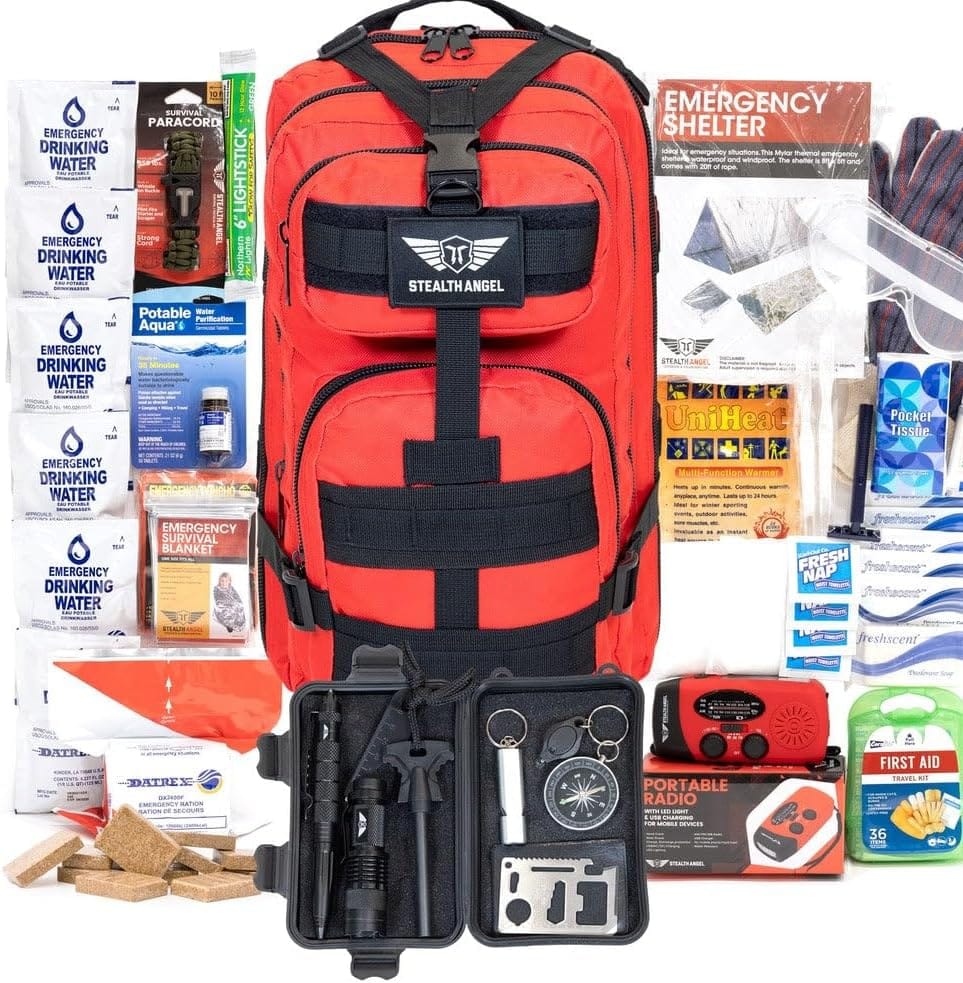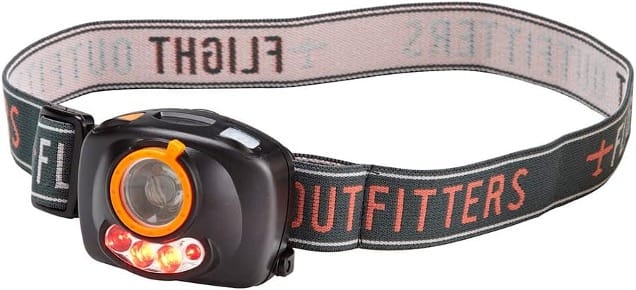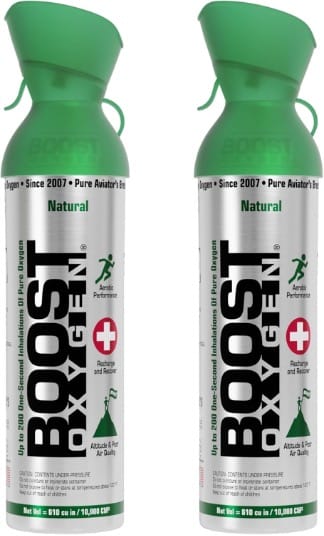When you take to the skies, preparation is as essential as precision. Whether you’re flying cross-country in a single-engine aircraft or navigating remote airstrips, having the right safety and survival gear can make all the difference, especially when the unexpected happens. From emergency locator beacons and first aid kits to compact survival tools designed specifically for aviators, modern products are engineered to keep you alive, visible, and connected when every second counts. In this review, we’ll explore the best safety and survival products every pilot should consider having onboard—essentials that transform emergencies into survivable situations.
Please note: As an Amazon Associate we earn from qualifying purchases.
Sporty's PJ2+ COM Aviation Handheld Radio
The PJ2+ COM Radio builds on its predecessor to offer a very pilot-friendly handheld aviation transceiver. This radio is designed to be simple, quick to deploy, and reliable in a backup scenario.
✅ Features & Benefits
- 6 Watts Peak Transmit Power – The PJ2+ offers up to 6 W PEP transmit power when running on its included AA battery pack, giving improved range compared to earlier handhelds.
Benefit: Better chance of reaching ATC or other stations when you’re away from the panel or using a backup radio. - Standard GA Headset Jacks + 3.5 mm Earbud/Headphone Jack – It includes the standard dual-plug (“PJ”) aviation headset jacks, and also a 3.5 mm jack for wired earbuds or computer-type headsets.
Benefit: Plug in your regular pilot headset quickly (no adapter), or use simpler earbuds if you prefer minimal gear for backup. - Large Back-lit High-Contrast Screen & Oversized Keypad – The PJ2 has an upgraded display with improved contrast and readability, plus a keypad designed for turbulence / one-handed operation.
Benefit: Easier to see and operate in low light or in flight conditions, less chance of error when you’re busy. - Simple, Pilot-friendly Interface – The unit emphasizes straightforward operation: on/off/volume knob, squelch control, “last-frequency” flip button, no complicated menu diving.
Benefit: When the unexpected happens (e.g., panel failure, emergency), you can fire it up and tune quickly without fumbling menus. - Dual-power Options: AA Battery Pack or USB-C External Power Input – The radio uses six AA alkaline batteries (excellent shelf life) and also supports being powered via USB-C (2.4 A).
Benefit: Reliable backup power you can stash and activate when needed; and the USB-C option gives flexibility with a power bank or car/aircraft USB supply. - Pilot-oriented Accessories Included – Comes with antenna, belt clip, wall plug, USB-A to USB-C cable, and the AA battery pack (batteries themselves not included) according to the listing.
Benefit: Ready to go out of the box as a backup radio; minimal additional purchases required. - Memory Channels, NOAA Weather Band, Emergency Frequency Button, Noise Limiting – The specification sheet mentions 20 memory channels, NOAA weather band, a dedicated 121.5 MHz emergency button, automatic noise limiter (ANL) feature.
Benefit: These features help with monitoring multiple frequencies, being alert to weather or emergency broadcast conditions, and clearer audio in noisy environments.
⚠️ Pros & Cons
Pros:
- Very good value for a handheld aviation COM radio with solid features (power, screen, simplicity).
- Large, backlit display and keypad: Makes frequency entry and use easier in turbulence or night operations.
- Designed for use in flight/emergency backup scenario: easy plug-in of headset, simple controls, AA batteries for long shelf-life.
- Dual audio connectivity: 3.5 mm jack in addition to GA jacks gives flexibility for non-aviation headsets or earbuds.
- Compact and portable enough to serve as a flight bag backup or handheld for flight line or ferry flights.
- Good build and design improvements over earlier version (PJ2) according to tested reviews.
Cons / Limitations:
- Being a handheld, even at 6 W it may not match the range or reliability of a full panel-mounted radio + aircraft antenna—especially inside a metal fuselage or without a good external antenna.
- Powered by AA batteries — excellent for shelf life, but you’ll want to carry spares and monitor battery condition. Rechargeable AAs are not recommended by the manufacturer.
- When powered via USB-C (instead of AA pack) the transmit power drops (to ~5W) according to the manual.
- Lacks 8.33 kHz channel spacing support: If you fly in regions or airspaces that require 8.33 kHz spacing (e.g., certain segments in Europe), this radio may not comply.
- As a handheld backup, you may still need to plan for antenna placement and mounting for best reception/transmission, if stored in a bag or behind the cockpit structure you may get limited performance.
- As a backup radio, it’s not a full panel replacement (no navigation functions, etc.): It’s designed for comm only, which may limit its utility if you were hoping for more advanced features.
📝 Summary
The PJ2+ COM Radio is a strong choice as a backup aviation communications radio. With a 6 W transmit power, pilot-friendly interface, standard aviation headset jacks plus 3.5mm compatibility, and flexible power/antenna options, it offers a nice balance of reliability and usability without breaking the bank. If your primary radio fails, or you want a handheld you can throw in the bag for ferry flights or remote trips, the PJ2+ has many of the features you’d want. Just keep in mind the inherent limitations of handheld radios (antenna placement, power vs fixed install, channel spacing) and plan accordingly.
Flight Gear Chockmate Tie-Down Kit
The ChockMate Tie-Down Kit is a portable, all-in-one anchoring solution for securing your aircraft wherever you land. It’s marketed for use on pavement or remote grass strips — designed to give you a quick, reliable way to tie down and chock an aircraft during a trip for safety and security.
✅ Features & Benefits
- All-in-one tie-down kit: Includes three anchor chocks (which also double as chocks), twelve heavy-duty nails for soft terrain, three 12-foot reflective orange ropes with rubberized hooks, and a dual-purpose hammer plus a rugged canvas tool bag.
Benefit: You get a complete portable solution for securing your aircraft — nothing extra to source separately if you’re heading to a remote field or paved ramp. - Anchor chocks with dual-purpose use: The chocks serve as both anchors for tie-down and as wheel chocks.
Benefit: Saves space and weight in your gear, useful for cross-country trips or when you carry tie-down gear in your aircraft. - High-visibility reflective ropes: The kit provides three 12′ sections of bright orange reflective rope with rubberized hooks (one end) and each rope rated (or noted) to ~1,760 lbs strength.
Benefit: Makes your tie-down lines easier to see (important for safety on the ramp or in low-light) and gives good strength for securing the aircraft. - Soft-terrain compatibility: The nails allow securing the anchor chocks into grass, sod, or other non-paved surfaces.
Benefit: Ideal for landing at grass strips or back-country fields where standard paved tie-down rings may not be available. - Portable and compact carrying case: The full kit packs into a canvas tool bag sized approx. 16” x 7.5” x 7.5”, weight ~14.2 lbs.
Benefit: Easy to stow in your aircraft, trunk, or hangar; convenient to transport and store when not in use. - Versatility – pavement to grass: The manufacturer emphasizes use at both paved facilities and remote grass strips.
Benefit: Offers flexibility for pilots who travel across different types of landing surfaces, giving one solution for varied operations.
⚠️ Pros and Cons
Pros:
- A very convenient “all-in-one” kit, so you don’t have to assemble separate chocks, ropes, nails, bag etc.
- Good portability and ease of transport — especially helpful for traveling aviators.
- High visibility ropes improve safety (less risk someone trips or you forget to tie down properly).
- Heavy-duty rope strength: each rope rated up to ~1,760 lbs, which is robust for typical GA tie-down loads.
- Designed for both paved and soft surface—adds flexibility for more adventurous operations.
- Dual-purpose chocks anchor means you get more utility from fewer pieces.
Cons / Considerations:
- While nails work in soft terrain, they may not be suitable for very hard surfaces (concrete aprons, asphalt) where you may still need standard tie-down rings or specialized hardware.
- The kit weight (~14.2 lbs) and size mean it still takes real space in your aircraft or hangar gear — so if you operate very light/small craft you’ll want to account for that.
- Reflective rope strength is good but depending on wind/wrap conditions and aircraft size, you may still want heavier duty tie-down systems for long-term exposure (e.g., overnight in high-wind areas).
- As with any tie-down gear, correct use (anchor placement, rope tensioning, checking hardware) is critical — the kit gives the gear, but you still need to apply good practice.
📝 Summary
If you’re a pilot who wants a portable, well-organized tie-down solution that works both at normal ramps and more remote fields, the Flight Gear ChockMate Tie-Down Kit offers a strong value proposition. It combines chocks, ropes, nails and a carry bag into one system designed for convenience, visibility and flexibility. For routine ramp use it provides a handy backup or travel kit; for remote or grass-field operations it gives you the ability to secure your aircraft where standard tie-down facilities may not exist. As always, ensure the gear fits your aircraft size, expected wind/tie-down loads, and destination terrain for best results.
VEITORLD 12‑in‑1 Emergency Survival Kit
This compact kit is marketed as an outdoor survival set. It comes in a small carry case (roughly 8 × 5 × 2 inches, approx. 1.25 lb). The idea is to have 12 essential tools to assist in emergency situations.
✅ Features & Benefits
- 12 essential survival items — The kit includes tools such as an upgraded survival knife, wire saw, water-bottle clip, emergency blanket, flint and scraper, flashlight, credit card knife, multi-use spoon/fork, carabiner and a waterproof box.
Benefit: Gives you a broad set of survival gear in one compact package instead of buying each tool separately. - Compact and portable — Packaged in a small, portable size (approx. “7.1 × 4.3 × 2.0 inches,”).
Benefit: Easy to stash in a flight bag, backpack, or travel bag — useful for unexpected forced landing/emergency situations in the aircraft. - Designed for outdoor use — The items (wire saw, emergency blanket, water-bottle clip) are geared toward hiking, camping, fishing, travel, general “adventure”, or emergency contexts.
Benefit: Helps provide peace of mind when away from civilization: you have tools for cutting, shelter, fire, water-carry etc. - Gift-style packaging / occasion friendly — The product listing emphasizes “Gifts for Men Dad Husband” for Father’s Day, birthdays, etc.
Benefit: If you’re buying for someone who “has everything,” it can be a nice all-in one present that still has practical value.
⚠️ Pros & Cons
Pros:
- Good value for the number of tools included — you’re getting many items for the price of one kit.
- Ideal as a backup or “just-in-case” kit for light outdoor/vehicle/travel/emergency use.
- Compact size makes it portable and easy to gift.
- Good value entry level kit for basic preparedness without buying many separate items.
Cons / Considerations:
- While it contains many items, quality and performance of each tool may be modest compared to buying dedicated high-end versions. For example, a “wire saw” in a small kit may work but not as robustly as a full-size chainsaw or serious field saw.
- Because it’s marketed as a gift, some items may be lightweight rather than professional-grade.
- The kit is designed more for general emergencies or light outdoor use — if you’re planning extended an extended flight over back-country areas or high-risk environments, you should consider more specialized gear (first-aid supplies, communication devices, navigation, high-end tools).
- Limited Specifics – exact tool specs (e.g., blade steel type, saw quality, blanket thermal rating) are not clearly detailed in the product listings, so performance may vary. Given the size & weight, this kit more suited for light emergencies rather than rugged survival scenarios.
📝 Summary
Overall, the VEITORLD 12-in-1 Emergency Survival Kit is a solid basic preparedness accessory, if you’re looking for a compact, affordable, all-in-one survival kit that covers a wide range of basic outdoor needs. It provides a variety of tools in one portable package, making it convenient to carry in a flight bag. However, if you require gear for very demanding or remote flight scenarios, you may want to supplement it with more rugged or specialized equipment. As always, for anticipated extreme survival situations, it’s wise to inspect the kit, test the components, and make sure you’re comfortable with their performance before relying on them.
Stealth Angel 1 Person 72-Hour Emergency Survival Kit
The Stealth Angel 1-Person Emergency Kit / Survival Bag (72 Hours) is a comprehensive, single-person survival backpack designed to cover the first 72 hours of a disaster/emergency scenario. It comes pre-packed and neatly organized in a high-quality backpack, with essentials in five major categories: food & water; light & communication gear; shelter & warmth items; tools; hygiene & sanitation; plus a 36-piece portable first-aid kit. The set is hand-assembled in the U.S. and according to the manufacturer, adheres to recommended prepping standards.
✅ Features & Benefits
- 72-Hour duration for one person — The kit is designed to supply one individual with essentials (food, water, supplies) for about 3 days (72 hours) after a disaster (forced landing) or evacuation.
Benefit: Gives you a pre-packaged, immediate “go-bag” you can grab if you need to evacuate or ride out a short-term emergency without waiting to assemble supplies. - Food & water included, shelf-life rated — For example: 6 water pouches (4 oz each) + six 400-calorie food bars (2,400 calories total) plus 10 water purification tablets. The food & water items claim a 5-year shelf life.
Benefit: Ensures you have basic sustenance ready on standby; long shelf-life means you can store it and not worry about immediate expiration. - Shelter & warmth supplies — Items such as emergency body warmers, emergency blankets, emergency poncho with hood, and tube tent with rope are included.
Benefit: Protects you from elements (rain, wind, sun) and helps maintain warmth or basic shelter—important if you’re outdoors or infrastructure is down. - Light & communication tools — Includes a tactical flashlight (Q5), keychain LED flashlight, hand‐crank / dynamo emergency radio & LED light, 12-hour light stick, survival whistle.
Benefit: Enables you to see in darkness or low light, receive/monitor emergency broadcasts, signal for help, and navigate more safely. - Tools & multi-function gear — Contains an 8-in-1 Everyday Carry Kit (e.g., tactical pen, multitool card, compass, ferro rod, work gloves, paracord bracelet, safety goggles) among other useful items.
Benefit: Gives you versatility and enhanced capability in emergencies—repairing, cutting, navigating, signalling, handling minor gear issues. - Hygiene, sanitation & first aid — It includes a hygiene kit (toothbrush/paste, soap, mask, etc), a 36-piece portable first-aid kit.
Benefit: Helps you maintain basic health, cleanliness, and treat minor injuries. - Pre-packed, ready to go — The kit comes neatly packaged in a survival bag/backpack ready for stash or transport.
Benefit: Saves you the time of hunting down each item individually; you can “grab & go” in an emergency. - Designed for natural disasters/emergencies — The company markets this for earthquakes, hurricanes, power outages, etc., it is however suitable for a downed aircraft survival scenario.
Benefit: Specifically tailored to scenarios where you need to be self-sufficient for a short period while waiting for help.
⚠️ Pros and Cons
Pros:
- Covers multiple survival needs at once: food, water, shelter, tools, hygiene, first aid — a truly all-in-one kit for one person.
- Good for immediate readiness: contains 72-hour supplies, which is often the baseline for disaster preparedness.
- Pre-packed and ready to go: eliminates the hassle of sourcing each item individually.
- Packaged in a sturdy backpack for portability and organized storage.
- Assembled in the U.S. and claims to follow expert & government guidelines.
- Includes many tools beyond basic kits – goes beyond “just food & water” to include communication, shelter, and tool options.
- Good for one-person coverage, which makes planning simpler if you want a kit per person.
Cons / Considerations:
- “72-hour” coverage may be sufficient for many emergencies, but if help is delayed longer, you may need additional supplies or a larger kit.
- Pre-packaged kits often include items of varying quality; you may want to inspect contents and possibly upgrade key items based on your needs. (As some users caution)
- Weight/size may still be substantial for some applications (aircraft space limitations) – you’ll want to check how heavy/bulky the bag is and whether it is suitable for your intended use.
- Depending on use case, the backpack size and weight may be more than you want for minimal kits.
- For aviation or high-risk scenarios, you may need more specialized gear (e.g., survival radio, more food/water, certified gear) than is included.
- Generic contents: The pre-packed nature means less customization (dietary, medical needs, region-specific gear).
- Maintenance required: Items like food, first aid, and water tablets may need periodic checking/replacement.
📝 Summary
The Stealth Angel 1-Person 72-Hour Emergency Kit / Survival Bag is a well-rounded, off-the-shelf “go bag” solution designed to support one person for approximately 72 hours in a disaster, emergency survival scenario. It covers the major survival categories (sustenance, shelter, tools, first aid, communication) and is convenient for storing at in the hanger, in a aircraft, or as part of an emergency survival plan.
If you’re looking for a ready-made kit that lets you quickly prepare for emergencies without sourcing each item individually, this is a strong option. However, as with any pre-packaged kit, it’s wise to review and possibly customize the contents to match your specific environment (e.g., aviation, remote terrain) and ensure it fits your personal needs (weight, carryability, duration beyond 72 hours).
Garmin inReach Mini 2 Satellite Communicator
The Garmin inReach Mini 2 is an ultra-compact satellite communicator built for off-grid scenarios. It offers global two-way messaging, location sharing and an interactive SOS function via the Iridium satellite network (subscription required). With a weight of just about 3.5 oz and a rugged design rated to IPX7 for water-resistance, it slips easily into a pack, belt or flight bag.
✅ Features & Benefits
Compact, lightweight form-factor
- The device weighs only 3.5 oz (≈ 100 g) and is sized ~3.9 × 2 × 1 inches.
Benefit: Easy to carry or mount/strap in aircraft, backpack or vehicle — minimal weight adds minimal burden. - Rugged build, impact-resistant and water-rated to IPX7 (can survive immersion up to 1 meter for 30 minutes).
Benefit: Suitable for harsh outdoor, marine or aviation use where moisture, vibration or rough handling may occur.
Global two-way satellite communication + SOS
- Enables two-way messaging and interactive SOS functionality (via Iridium satellite network) — an active subscription is required.
Benefit: Even in remote areas where cell service doesn’t reach (mountains, wilderness, remote airstrips), you can send and receive messages and trigger SOS for rescue. - “TracBack®” routing lets you navigate back along your path.
Benefit: Useful if you’re navigating unfamiliar terrain, in an aircraft off-field landing, or if you need to retrace steps safely. - MapShare™ and location sharing allow you to share your coordinates and allow others to track your position.
Benefit: Enhances safety by letting ground contacts or other crew know where you are; good for pilot/instructor flying, remote operations, logistics.
Integration with smartphone/app & GPS features
- Works with the Garmin Explore™ app to plan trips, sync waypoints/activities, manage routes.
Benefit: Allows pre-planning and post-mission analysis; supports flight prep and navigation workflows. - Digital compass even when stationary.
Benefit: Helpful in aviation or ground operations when you need heading information without movement (e.g., parked aircraft, staging area). - Location tracking and waypoint support (1,000 waypoints according to spec).
Benefit: Supports complex missions with multiple legs, remote waypoints, or multi-stop trips.
Strong battery life with flexible tracking options
- Up to 14 days of battery life in a 10-minute tracking mode under full sky view.
Benefit: Long endurance for extended missions, back-country flying, ferry flights, or remote ops where charging may be limited. - Tracking interval can be extended to 30 minutes, which allows up to 30 days battery life in full sky view.
Benefit: Flexibility to adjust tracking frequency to conserve power when necessary (e.g., staging vs active travel).
⚠️ Pros and Cons
Pros:
- Excellent safety/communication backup for remote locations, off-grid flights, or emergency scenarios.
- Ultra-light and compact — ideal for aviation carry, flight bags, handheld backup.
- Robust build suitable for challenging environments (weather, vibration, movement).
- Strong battery life supports longer deployments and less frequent recharging.
- Supports navigation/waypoints and integrates with planning app workflows.
- Excellent global coverage: Because it uses the Iridium satellite network, you can send/receive messages and trigger SOS even where there’s no cell service.
- Very lightweight and compact: At about 3.5 oz, it won’t really add noticeable bulk or weight to your kit.
- Rugged build: IPX7 rated for water resistance, built for outdoor use.
Cons / Considerations:
- Requires an active satellite subscription to use full two-way messaging and SOS capabilities.
Note: Subscription costs and plan terms should be factored in. - While compact, the display and user interface are limited compared to full handheld GPS devices — might require smartphone integration for map display.
- Dependent on clear view of sky for best satellite performance; in dense canyons, inside aircraft fuselage or deep forest cover performance may degrade.
- For purely aviation use, installation/mounting considerations (e.g., accessible, visible, in case of emergency) need planning.
- Cost tends to be higher vs basic PLB (Personal Locator Beacon) devices — but you get added two-way messaging and tracking.
📝 Summary
The Garmin inReach Mini 2 is a highly capable compact satellite communicator that brings two-way message capability, SOS/rescue functionality, navigation tools and strong battery endurance into an ultralight form-factor. It’s particularly appealing for aviators, remote operations, back-country pilots, and anyone needing global connectivity beyond cell coverage. It provides a strong layer of safety and communications for scenarios where standard radios/cellphones may fail.
If you’re in aviation (general aviation, bush flying, remote field operations) this device can serve as an excellent backup communications & tracking tool, complementing your standard avionics and emergency gear. For optimal use, integrate it into your flight preparation, ensure you understand subscription costs, and mount/stow it for easy access in a real-emergency scenario.
ACR ResQLink View - Buoyant Personal Locator Beacon with GPS
The ResQLink View is a compact, buoyant Personal Locator Beacon designed for extreme–environment reliability. With no subscription required, it combines GPS/Galileo positioning, a powerful 406 MHz distress signal, and a homing 121.5 MHz signal to alert search & rescue satellites and guide them to within 100 m (or less) of your position.
✅ Features & Benefits
- No subscription required — The ResQLink View operates without a recurring subscription fee.
Benefit: Once purchased and registered, you’re ready to deploy in an emergency without ongoing costs. - GPS & Galileo GNSS support — The unit includes both GPS and Galileo satellite positioning systems.
Benefit: Improved global positioning accuracy and redundancy so rescuers get precise coordinates when you activate. - Global coverage, MEOSAR compatible — The beacon transmits on the 406 MHz emergency frequency and is compatible with MEOSAR satellite systems.
Benefit: Rescue alert coverage anywhere worldwide, including remote land, sea or aviation environments. - Dual-band signalling: 406 MHz distress + 121.5 MHz homing — The unit has three levels of signal tech: 406 MHz to the satellites, 121.5 MHz homing signal, plus GNSS.
Benefit: Means your location is broadcast to satellites and local search & rescue units can home in on your signal for final approach. - Built-in buoyancy — The device is buoyant.
Benefit: Suitable for marine/aviation over-water operations—if you end up in the water, the beacon remains afloat and operable. - Strobe & infrared strobe lights — Integrated strobe and IR strobe provide visibility in low-light or night-time rescues.
Benefit: Improves chances of detection by aircraft or rescue teams in darkness or poor lighting conditions. - Digital display showing live status & coordinates — The beacon includes a digital read-out to view live status and GPS coordinates.
Benefit: You (and potentially others) can verify the beacon is active and see the exact coordinates being sent – enhances confidence and situational awareness. - Small & lightweight — Dimensions approx. 4.52 in x 2.03 in x 1.49 in (11.48 cm x 5.16 cm x 3.78 cm); weight ~0.326 lbs (148 g).
Benefit: Easy to carry, mount in aircraft, or pack into survival/flight gear without taking up much space or adding significant weight. - Operational life & battery life — The product lists 28 hours operational life.
Benefit: Enough endurance in many emergency situations while you await rescue. - Wide temperature & environmental tolerance — Storage: -30 °C to +70 °C; Operating: -20 °C to +55 °C. Waterproof rating: 5 m for 1 hour, 10 m for 10 minutes.
Benefit: Rugged enough for harsh environments — aviation, marine, mountaineering or remote usage. - Multifunction clip system & custom “skins” included — The unit includes wear/attachment options and skins to tailor to gear or activity.
Benefit: Flexible mounting (vest, life-jacket, gear bag) and aesthetic personalization or activity-specific identification. - Buoyancy and professional engineering/tested construction — The description emphasises “military durability” and “professionally engineered and tested.”
Benefit: High confidence in reliability when lives depend on it; build quality appropriate for aviation, marine, or back-country use.
⚠️ Pros and Cons
Pros:
- Excellent coverage and redundancy (GNSS + 406 MHz + 121.5 MHz) for global emergency signalling.
- No ongoing subscription means simpler ownership and deployment.
- Lightweight and compact — suitable for aircraft carry, hiking, kayaking, remote operations.
- Built-for-purpose ruggedness (buoyancy, wide temperature range) — fits aviation/remote scenarios.
- Digital display gives enhanced user feedback (status & coordinates) versus many simpler beacons.
Cons / Considerations:
- As with all PLBs (Personal Locator Beacons), it is a “signalling device” not a communication device — you cannot exchange two-way messages (unless additional gear used). It signals rescue.
- The operational life (~28 hours) while good, still places a limit — if rescue is delayed longer or conditions extreme, you might wish for longer endurance or backup.
- The cost is relatively higher compared to very basic emergency beacons, but that is commensurate with the added features and build.
- Installation/mounting in aircraft must still follow best practices (easy access, antenna deployment, away from interference) to get full performance.
- Because it uses lithium batteries and is a beacon, there may be airline/transport regulations about carriage (though the manufacturer does mention carry-on/checked under certain rules).
📝 Summary
The ACR ResQLink View PLB is a top-tier personal locator beacon engineered for serious use in aviation, marine, back-country, remote or high-risk environments. It combines global satellite distress signalling, local homing, GPS/Galileo positioning, buoyancy, rugged environmental tolerances and a digital user interface in a compact package. For pilots, kayakers, mountaineers or travellers who might find themselves in isolated situations where standard communication fails, this beacon offers a high-level layer of emergency preparedness.
If you are evaluating gear for aviation safety, remote field operations or outdoor survival, this beacon is a strong investment — especially when compared to simpler models. That said, you should still treat it as part of a layered safety system (radio, cell/satellite phone, PLB, survival gear) and ensure your mounting, registration and activation procedures are fully understood and practiced.
Flight Outfitters Headlamp (Black/Orange)
This headlamp from Flight Outfitters is designed for aviation and night-use scenarios, offering both white and red LED lighting via separate switches. The white flood beam is rated at about 80 lumens. It comes with an elastic headband and a pivoting mount so you can angle the light where you need it. It uses three AAA batteries (included) and has both high and low settings for each color of light (white and red).
✅ Features & Benefits
- Dual-color lighting: both white LED flood light (for pre-flight checks and exterior work) and red LED lights (for cockpit tasks and preserving night vision).
Benefit: Gives you the flexibility to use bright white light when needed, and switch to red light to avoid disturbing your night vision or fellow crew. - Independent dual switches: one button (orange) controls the white light (high/low), and the other button (gray) controls the red LEDs (two brightness levels).
Benefit: Fast and intuitive control in low-light environments—no cycling through modes to find red light only. - Adjustable elastic headband + pivoting headlamp unit.
Benefit: Comfortable, hands-free wear; you can angle the beam exactly where you need it while keeping your hands free (important in cockpit or field operations). - Specifications: approx. 80 lumens output for white mode, uses 3 AAA batteries, runtime about 4 hours, weight about 2.3 oz (without batteries).
Benefit: Lightweight and compact—suitable for wearing for extended periods or stowing in your flight bag; standard battery type (AAA) means spares are easy to carry. - Designed for aviators / night flying tasks. The headlamp is marketed for pre-flight, exterior work, cockpit lighting.
Benefit: Tailored to the specific needs of pilots—having appropriate lighting that doesn’t compromise night vision or interfere with cockpit instruments.
⚠️ Pros and Cons
Pros:
- Excellent utility for both high-visibility tasks (white light) and low-glare/night-vision tasks (red light).
- Independent controls avoid flashing the wrong color or cycling through many modes — great under pressure.
- Elastic headband and pivoting light head provide hands-free, versatile lighting.
- Light weight (≈2.3 oz without batteries) and compact; easily portable or stowable.
- Designed with aviation context in mind—so likely optimized for pilot use rather than generic headlamps.
- Uses common AAA batteries rather than proprietary packs (makes replacements easy).
Cons / Considerations:
- Runtime is relatively modest (~4 hours) especially under white high mode—if you’re using it extensively you might need spare batteries.
- 80 lumens output is decent but not extremely bright compared to high-end outdoor headlamps; for very dark or remote exterior work you might prefer higher output.
- As a dedicated aviation headlamp, it may lack some outdoor-specific ruggedness (waterproofing, extreme brightness) compared to headlamps designed for heavy-duty outdoor use.
- Battery-powered (AAA) means performance may vary with battery quality; can be less convenient than rechargeable packs for heavy use.
- Some users report potential weak points in the mounting pivot/hardware (based on user reviews).
📝 Summary
If you’re a pilot or someone working in aviation or night operations who needs a reliable hands-free light that supports both white and red lighting modes, the Flight Outfitters Headlamp (Black/Orange) is a strong option. It delivers good flexibility, intuitive controls, and lightweight design tailored to cockpit/exterior work. While it may not match ultra-high-end outdoor headlamps in extreme brightness or ruggedness, for aviation tasks it offers well-balanced performance for its price. If you routinely operate in very dark, remote environments or require extended runtime, you might still consider supplementing it with a higher-output or rechargeable headlamp.
Boost Oxygen Large Natural 10L Canister
This product is a 10-liter disposable canister of bottled oxygen (≈ 95% purity) designed for supplemental breaths in flight or other oxygen-deficit situations. According to the listing, it “contains 95% pure oxygen… with a connected mask that contains over 200 one-second inhalations.” It is marketed especially for aviation use (e.g., at altitude) to counter symptoms of oxygen deficiency such as fatigue, stress, low energy and lack of focus.
✅ Features & Benefits
- Approx. 95 % pure supplemental oxygen (99.5 % at fill) in a portable canister — The product is described as “pure supplemental oxygen… filled with 99.5% oxygen, nearly 5× the amount of normal air (which is ~21% oxygen)”.
Benefit: Provides a concentrated dose of oxygen compared to ambient air, which may support breathing when ambient oxygen or air quality is lower than ideal (e.g., high altitude, physical exertion, or polluted air). - No prescription required (for non-medical use) — The company states it is “not a substitute for individuals who have been prescribed medical oxygen” and is for non-medical use like athletes, travel, older adults, etc.
Benefit: Easier access for general wellness, recovery, or recreational use without needing a medical prescription. - Convenient, lightweight, portable format — The canisters come in multiple sizes (3 L “pocket size”, 5 L “medium”, 10 L “large”) and are designed for on-the-go use.
Benefit: Good for travel, outdoor activities, altitude exposure, or just carrying in a bag/cabin for when extra oxygen might help. - All-natural, odorless version (Natural flavour/aroma) — The “Natural” version has no added aroma, unlike other variants that include scented aromatherapy “Boost Oxygen” versions.
Benefit: Suitable for those who prefer unscented or neutral-smelling products, reducing potential interference (e.g., in cockpit or professional use) and avoiding extra fragrances. - Supports recovery, performance, altitude acclimation & general wellness — According to the brand: “used by athletes for recovery and performance, older adults for active lifestyle, people at high altitudes or in poor air quality”.
Benefit: Offers versatility for a variety of use cases — from fitness recovery, to aviation/altitude situations, to general wellness or high-effort tasks. - Manufactured in the USA & recyclable packaging — The brand notes that the canisters are recyclable and made in the USA.
Benefit: Offers assurance about manufacturing origin, and the recyclable aspect helps from a sustainability standpoint.
⚠️ Pros and Cons
Pros:
- Very high concentration of oxygen compared to ambient air, so it can be useful when oxygen availability is reduced (e.g., high altitude, strenuous exertion).
- Ready-to-use, portable solution — no equipment or setup required beyond inhaling from the canister.
- Unscented “Natural” version means no fragrance interference — good for sensitive users or professional use (e.g., pilots, flight crews).
- Comes in multiple sizes for flexibility (from pocket size to large canister) to suit different scenarios/travel needs.
- Non-prescription access makes it easier for general consumers and athletics/travel users.
Cons / Considerations:
- This is not a medical oxygen system and must not be used as a substitute for prescribed oxygen therapy in medically indicated cases. The brand states this outright.
- The canister gives a limited number of “one-second inhalations” depending on size — so it's not a continuous supply system. For example, the large 10 L canister provides about “200 one-second inhalations” according to the product description.
- Carrying compressed oxygen canisters may have travel or regulatory restrictions — for example, the brand notes that the product may not be allowed on commercial flights depending on airline/TSA regulations.
- The benefits (recovery, performance, altitude support) are not the same as clear clinical evidence in all use cases — the company expressly says the product is not FDA approved as a medical treatment.
- The value and actual impact may vary with the individual, the activity, the ambient environment (altitude, air quality), and the number/quality of inhalations.
📝 Summary
The Boost Oxygen Natural portable oxygen canister is a convenient, non-prescription supplemental oxygen option aimed at supporting wellness, recovery, performance, altitude acclimation, and situations of reduced air quality. With about five times the oxygen concentration of ambient air, in a portable/canister format, it offers a flexible tool for travel, outdoor activities, fitness efforts, and other non-medical applications. The unscented “Natural” version makes it particularly versatile for users who prefer minimal fragrance or professional settings (e.g., aviation).
However, users should keep in mind that this is not a substitute for medically prescribed oxygen therapy and that its usefulness depends on proper expectations, scenario use (e.g., high altitude, exertion, travel), and compliance with any applicable safety/travel regulations. For serious medical conditions or continuous oxygen needs, a professional medical system is required.
Amerex B385TS 2.5 lbs Halotron I Fire Extinguisher with Aviation Bracket
The Amerex B385TS is a 2.5-pound clean-agent fire extinguisher using Halotron I, designed for Class B (flammable liquids/gases) and Class C (live electrical equipment) fires. Halotron I leaves essentially no residue, is non-conductive, non-corrosive, and is suitable for sensitive environments like electronics rooms, data centers, aircraft, or vehicles.
✅ Features & Benefits
- Clean-agent Halotron I: This extinguisher uses Halotron I, a rapidly evaporating liquid agent that is non-conductive, non-corrosive, and leaves no residue.
Benefit: Ideal for environments with sensitive electronics, aircraft cabins, engine compartments, or clean rooms where leftover powder (from dry-chemical extinguishers) would cause damage, cleanup or downtime. - UL/ULC rating 2B:C: The unit is rated to fight Class B (flammable liquids) and Class C (electrical) fires under the 2B:C classification.
Benefit: It’s rated for typical high-risk hazards (liquids, electrical) making it appropriate for aviation, vehicle engine bays, electronics bays, or facility equipment rooms. - Stored-pressure design with drawn‐steel cylinder & all-metal valve: The extinguisher is constructed with a durable steel cylinder, an anodized aluminum valve, and stored-pressure operation.
Benefit: Robust construction ensures reliability in harsh conditions (vibration, temperature extremes), important in vehicle, aviation or industrial use. - Performance specs: discharge time, range, temperature tolerance: For model B385TS: approx. 9 seconds discharge time; initial range about 6-10 ft. Temperature rating from -40 °F to 120 °F.
Benefit: Gives you a quick burst of agent with sufficient reach and wide temperature operability—useful for outdoor vehicle/aircraft mounts, engine compartments, or cold/hot ambient conditions. - Environmentally minded agent: Halotron I has very low ozone-depletion potential (ODP ≈0.0098 relative to CFC-11=1.0) and relatively low global‐warming potential (GWP around 77) compared to many other agents.
Benefit: For operations with environmental, regulatory, or clean-room sensitivity this provides a “clean” suppression agent that better aligns with modern regulations and asset-protection. - Compact size & included bracket: Height approx. 15.5 in, width ~6.38 in, depth ~3 in. Included bracket mount suitable for aircraft.
Benefit: The size makes it suitable for mounting in confined spaces such as aircraft cockpits, engine compartments, service vehicles, ramps, or mobile installations. - Suitable for specialized environments: Manufacturer cites applications including model-aircraft to wide-body commercial aircraft, data-centers, labs, telecommunication facilities, engine/vehicle compartments, etc.
Benefit: If you’re in aviation, maintenance, electronics or high-value asset operations where traditional dry-chemical extinguishers might cause collateral damage, this unit is designed to address those use-cases.
⚠️ Pros & Cons
Pros:
- Clean-agent means minimal downtime and cleanup after discharge — safe around electronics/engines.
- Built for harsh environment/usability: wide temperature range, rugged build, good reach.
- Environmentally better than many older agents (Halon-1211, etc).
- Compact and mountable in vehicle/aircraft/engine compartments.
- Trusted brand with long history in aviation/industrial suppression.
Cons / Considerations:
- The discharge time is quite short (~9 seconds) because it’s only 2.5 lb capacity — smaller mass means less total agent compared to larger extinguishers.
- Given its clean-agent design, the cost is significantly higher than basic dry-chemical extinguishers.
- Although rated for Class B and C, for large Class A (ordinary combustibles) fires, you may still prefer larger capacity A-rated units.
- Mounting and vehicle/aircraft certification: While suitable for those environments, installation must follow proper bracket and securing standards (especially in aviation contexts).
- If stored in very harsh environments or subject to improper mounting/vibration, service/inspection intervals still apply.
📝 Summary
If you’re looking for a high-performance, compact fire extinguisher that uses a clean-agent (Halotron I) and is suitable for environments where residue, contamination, or damage from dry-chemical agents must be minimized (for example aircraft, engine bays, electronics rooms, vehicles servicing aviation), then the Amerex B385TS is a solid choice. Its balance of rugged construction, clean suppression agent, environmental credentials and relatively compact size makes it well suited for specialized applications.
However, if your primary requirement is a large coverage, long duration extinguisher for general facility use (especially major Class A hazards) then you might need a larger capacity unit or a more general-purpose solution instead of this smaller, specialized model.

